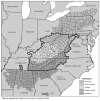Substance Use in Rural Central Appalachia: Current Status and Treatment Considerations
- PMID: 29057030
- PMCID: PMC5648074
- DOI: 10.1037/rmh0000064
Substance Use in Rural Central Appalachia: Current Status and Treatment Considerations
Abstract
The burden of substance use and especially the unmatched rates of overdoses in rural Central Appalachia highlight the need for innovative approaches to curb the initiation to drug misuse and to address current substance use disorders. Effective substance use interventions involve a thorough understanding of the region. In Central Appalachia, many of the barriers to treatment are shared with other rural and impoverished areas, including a lack of access to health care and lack of health care providers with specialized training. Parts of Appalachia also present their own considerations, including the challenges of fostering trust and encouraging treatment-seeking in communities with dense, long-term, place-based social and family networks. Current policies and interventions for substance use have been largely inadequate in the region, as evidenced by continued increases in substance use and substance-related deaths, especially related to nonmedical prescription drug use and increasing heroin use. The authors discuss ways in which rural life, poverty, identity, and values in Appalachia have influenced substance use and treatment and propose strategies and interventions to improve outcomes.
Keywords: Addiction; Appalachia; injection drug use; opioid use; rural; treatment.
Figures



References
-
- Abbott PJ. A review of the community reinforcement approach in the treatment of opioid dependence. Journal of Psychoactive Drugs. 2009;41(4):379–385. - PubMed
-
- Abbott PJ, Moore BA, Weller SB, Delaney HD. AIDS risk behavior in opioid dependent patients treated with community reinforcement approach and relationships with psychiatric disorders. Journal of Addictive Diseases. 1998;17(4):33–48. - PubMed
-
- Algeo K. Locals on local color: Imagining identity in Appalachia. Southern Cultures. 2003;4(4):27–54.
-
- Appalachian Regional Commission. Graph illustration of the Appalachian region. 2013 Retrieved August 8, 2016, from https://www.arc.gov/appalachian_region/TheAppalachianRegion.asp.
Grants and funding
LinkOut - more resources
Full Text Sources
Other Literature Sources
